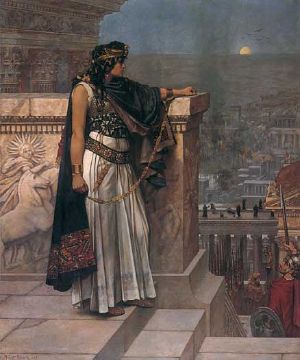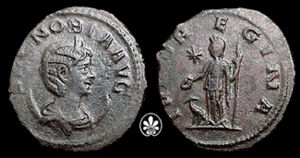Zenobia
Zenobia (Arabic: زنوبيا, 240-after 274) was a Syrian queen who lived in the third century. She was a queen of the Palmyrene Empire and the second wife of King Septimius Odaenathus. Upon his death, she became the ruler of the empire. In 269, she conquered Egypt, expelling the Roman prefect, Tenagino Probus, whom she beheaded when he led an attempt to recapture the territory. She then proclaimed herself queen of Egypt. She ruled Egypt until 274, when she was defeated and taken as a hostage to Rome by Aurelian. Zenobia appeared in golden chains in Aurelian’s military triumph parade. Impressed by Zenobia, Aurelian freed her and granted her an elegant villa in Tibur (modern Tivoli, Italy). She became a prominent philosopher, socialite, and Roman matron. Prominent Romans are counted as her descendants.
Biography
Family, ancestry, and early life
Zenobia was born with the name Iulia (or Julia) Aurelia Zenobia. Her name in the Arabic language is al-Zabba' bint Amr ibn Tharab ibn Hasan ibn 'Adhina ibn al-Samida or ('الزباء بنت عمرو بن الظرب بن حسان ابن أذينة بن السميدع), but is most commonly referred to simply as al-Zabba'; in Greek Ζηνοβία and she is known as Xenobia or Septimia Zenobia (she added that name to her name when she married Septimius Odaenathus). Zenobia would put on official documents, Bat-Zabbai (daughter of Al-Zabba). Zenobia and her mother were called Al-Zabba, meaning "the one with long lovely hair."
Her father, Zabaii ben Selim, or Iulius (or Julius) Aurelius Zenobius, was a chieftain of Syria in 229 and her mother may have been Egyptian. Her father’s gentilicium Aurelius shows that his paternal ancestors received Roman citizenship under either Roman Emperor Antoninus Pius (reigned 138-161), Marcus Aurelius (reigned 161-180), or Commodus (reigned 180-192). Zenobia was born and raised in Palmyra, Syria. The theory that her mother was Egyptian is based on the fact that Zenobia knew the ancient Egyptian language very well and had a strong predisposition toward the ancient culture of Egypt. Inscriptions found at Palmyra show that Zenobia’s father had a Greek name, Antiochus. However, according to Augustan History (Aurel. 31.2), his name was Achilleus and his usurper was named Antiochus (Zos. 1.60.2).
Zenobia’s near ancestry is not known for certain. However, her father’s paternal ancestry is traceable up to six generations and includes Sampsiceramus, a Syrian chieftain who founded the Royal Family of Emesa (modern Homs, Syria) and Gaius Julius Bassianus, a high priest from Emesa and father of Roman Empress Julia Domna.
Zenobia claimed to be a descendant of Dido, Queen of Carthage, the King of Emesa Sampsiceramus and the Ptolemaic Greek Queen Cleopatra VII of Egypt. According to Augustan History, an imperial declaration in 269 of hers was sent to the citizens of Alexandria, Egypt, describing the city as “my ancestral city.” This declaration only fits Vaballathus, the son of Zenobia. Historian Callinicus dedicated a 10-book history on Alexandria’s history to a "Cleopatra," who can only be Zenobia.
Zenobia is descended from the three above named figures through Drusilla of Mauretania. Drusilla was a daughter of King Ptolemy of Mauretania and Queen Julia Urania of Mauretania. Drusilla’s mother most probably came from the Royal Family of Emesa and Drusilla married into that Royal Family. Drusilla’s paternal grandmother Queen of Mauretania Cleopatra Selene II, was a daughter of Ptolemaic Greek Queen Cleopatra VII of Egypt and Roman Triumvir Mark Antony. Drusilla’s paternal grandfather African King Juba II of Mauretania claimed to be a descendant of the sister to the General of Carthage, Hannibal (Lucan. Pharsalia 8.287). Hannibal’s family, the Barcids, claimed to be descended from Dido’s younger brother.
Zenobia was described as beautiful and intelligent. She had a dark complexion, her teeth were pearly white, she had black bright eyes that sparkled, and had a beautiful face. Zenobia had a strong and melodic voice and many charms. Zenobia was well educated and knew Greek, Aramaic, Egyptian, and Latin. She was very interested in history and the works of Homer, Plato and other writers from Greece. She also enjoyed hunting animals and drinking.
Queen of Palmyra
Zenobia married King of Palmyra Septimius Odaenathus by 258 as his second wife. She had a stepson Hairan, a son from Odaenathus’ first marriage. As in 258, there is an inscription "the illustrious consul our lord" at Palmyra, dedicated to Odaenathus who was chief of Palmyra, by Zenobia, who was a supporter of his.
Around 266, Zenobia and Odaenathus had a son, his second child, Lucius Iulius Aurelius Septimius Vaballathus Athenodorus. Her son Vaballathus (Latin from Arabic وهب اللات Wahballāt, "Gift of the Goddess") inherited the name of Odaenathus’ paternal grandfather.
In 267, Zenobia’s husband and stepson were assassinated. The titled heir, Vaballathus, was only a year old, so his mother succeeded her husband and ruled Palmyra. Zenobia bestowed upon herself and her son the honorific titles of Augusta and Augustus.
In 269, Zenobia, her army, and the Palmyrene General Zabdas violently conquered Egypt with help from their Egyptian ally, Timagenes, and his army. The Roman prefect of Egypt, Tenagino Probus and his forces, tried to expel them from Egypt, but Zenobia's forces captured and beheaded Probus. She then proclaimed herself Queen of Egypt.
After these initial forays, Zenobia became known as a "Warrior Queen." In leading her army, she displayed significant prowess: she was an able horse rider and would walk three or four miles with her foot soldiers.
Zenobia with her large army made expeditions and conquered Anatolia as far as Ancyra or Ankara and Chalcedon, then to Syria, Palestine, and Lebanon. In her short lived empire, Zenobia took the vital trade routes in these areas from the Romans. Roman Emperor Aurelian, who was at that time campaigning with his forces in the Gallic Empire, probably did recognize the authority of Zenobia and Vaballathus. However this relationship began to degenerate when Aurelian began a military campaign to reunite the Roman Empire in 272-273. Aurelian and his forces left the Gallic Empire and arrived in Syria. The forces of Aurelian and Zenobia met and fought near Antioch. After a crushing defeat, the remaining Palmyrenes briefly fled into Antioch and into Emesa.
Zenobia was unable to remove her treasury at Emesa before Aurelian successfully entered and besieged Emesa. Zenobia and her son escaped from Emesa on camel back with help from the Sassanids, but they were captured on the Euphrates River by Aurelian’s horsemen. Zenobia’s short-lived Egyptian kingdom and the Palmyrene Empire had ended. The remaining Palmyrenes who refused to surrender were captured by Aurelian and were executed on Aurelian’s orders. Among those who were executed was Zenobia's chief counselor and Greek sophist, Cassius Longinus.
Zenobia and Vaballathus were taken as hostages to Rome by Aurelian. Vaballathus is presumed to have died on his way to Rome. In 274, Zenobia appeared in golden chains in Aurelian’s military triumph parade in Rome. Aurelian, out of clemency, impressed by her beauty and dignity, freed Zenobia. Aurelian granted her an elegant villa in Tibur (modern Tivoli, Italy).
She lived in luxury and she became a prominent philosopher, socialite, and Roman matron. Zenobia married a Roman governor and senator whose name is unknown. They had several daughters, whose names are also unknown, but who are known to have married into Roman noble families. There is a claim, after Aurelian’s defeat Zenobia committed suicide, however, this is not likely. She would have further descendants surviving in the fourth century and century.
Legacy
Prominent Romans are counted as her descendants, with evidence of such confirmed by an inscription found in Rome. The inscription Lucius Septimia Patavinia Balbilla Tyria Nepotilla Odaenathiania contains the names of her first husband Septimius Odaenathus. He probably was named in the honor of Zenobia's first husband. (After the deaths of Odaenathus and his sons, Odaenathus had no descendants). Another possible descendant of Zenobia is Saint Zenobius of Florence, a Christian bishop who lived in the fifth century.
Zenobia conquered new territories and increased the Palmyrene Empire in the memory of her husband and as a legacy to her son. Her stated goal was to protect the Eastern Roman Empire from the Sassanid Empire, for the peace of Rome, however her efforts significantly increased the power of her throne.
Zenobia in literature and the theater
- Geoffrey Chaucer, The Monk's Prologue and Tale, in The Canterbury Tales, vv. 359-486
- The Irish dramatist Arthur Murphy wrote a tragedy entitled Zenobia, which was first produced in 1768.
- Nathaniel Hawthorne's The Blithedale Romance features a character named Zenobia.
- Zenobia was the heroine of Alexander Baron's novel The Queen of the East, published in paperback by Panther in 1960; a reasonably persuasive fictional account of her conflict with the Roman Emperor, Aurelian.
- Louis de Wohl's The Living Wood contains many references to Zenobia.
- Beloved, by Bertrice Small, is a fictitious retelling (historical novel) of Zenobia's life. ISBN 0-345-32785-3
- The Chronicle of Zenobia: the Rebel Queen, by Judith Weingarten (Pegasus 2006).
- Haley Elizabeth Garwood, 'Zenobia' (2005, IBSN 0-9649721-3-5).
- Ethan Frome, by Edith Wharton, contains a manipulative character named Zenobia Pierce
- Stranger in a Strange Land, by Robert A. Heinlein, contains a character with the middle name Zenobia, daughter of Anne (by Valentine Michael Smith).
- "Rites of Passage," by William Golding contains an actress by the name of Zenobia.
- "Hand maiden of Palmyra," by Fleur Reynolds. Erotic novel featuring Queen Zenobia.
- In the 1977 Sinbad Film, Sinbad and the Eye of the Tiger, the main villain is a sorceress named Zenobia.
- In 2007, Mansour Rahbani, a Lebanese composer and producer, produced a musical named Zenobia. The musical is a fictitious retelling of Queen Zenobia's life.
- Zenobia has been the heroine of three operas: Tomaso Albinoni's Zenobia (1694), Pasquale Anfossi's Zenobia in Palmira (1789), and Rossini's Aureliano in Palmira (1813).
- In P.G. Wodehouse's novel, Joy in the Morning, one of the female characters is named Zenobia Hopwood, usually addressed as "Nobby."
- In Anthony Burgess' novel; The Doctor is Sick, a map labelled Zenobia is hanging on the wall of Mr Chasper's office.
ReferencesISBN links support NWE through referral fees
- Dear, Nick. Zenobia. Boston: Faber and Faber, 1995. ISBN 978-0571176762
- Garwood, Haley Elizabeth. Zenobia. Franklin, Ky.: Writers Block, 2005. ISBN 978-0965972130
- Jackson-Laufer, Guida. Women Who Ruled. Santa Barbara, Calif.: ABC-CLIO, 1990.
- Kephart, Matthew, and Emmens, Beth. Zenobia. Staten Island, NY: Berrett-Koehler Publisher, 2007. ISBN 978-1576755495
Historic sources
- Trebellius Pollio, Tyranni triginta xv, xvi, xxx
- Augustan History, Scriptores Historiae Augustae
- Flavius Vopiscus, Divus Aurelianus xxii-xxx, xxxiii-xxxiv
- The Monkes Tale - Geoffrey Chaucer, Notes to the Canterbury Tales
External links
- Zenobia and Longinus
- Vaballathus and Zenobia
- Zenobia: empress of Palmyra (267-272)
- Zenobia as a third-century queen of Palmyra
Credits
New World Encyclopedia writers and editors rewrote and completed the Wikipedia article in accordance with New World Encyclopedia standards. This article abides by terms of the Creative Commons CC-by-sa 3.0 License (CC-by-sa), which may be used and disseminated with proper attribution. Credit is due under the terms of this license that can reference both the New World Encyclopedia contributors and the selfless volunteer contributors of the Wikimedia Foundation. To cite this article click here for a list of acceptable citing formats.The history of earlier contributions by wikipedians is accessible to researchers here:
The history of this article since it was imported to New World Encyclopedia:
Note: Some restrictions may apply to use of individual images which are separately licensed.

